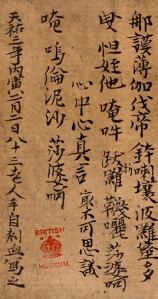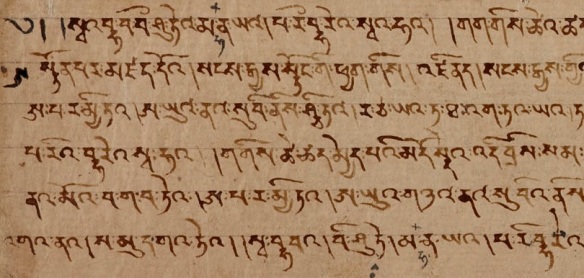There is something compelling about the idea of a text written in blood. The 20th century Chinese writer Lu Xun once said “Lies written in ink can never disguise facts written in blood.” Here the phrase “written in blood” is metaphorical — Lu Xun was talking about the killing of student protesters — but resonates with Chinese history, as China does actually have a tradition of writing in blood. The tradition was especially present in Buddhism and the earliest surviving examples we have are from the Dunhuang manuscript collections. For example, there is a booklet containing the Diamond Sutra (S.5451) with the following colophon (as translated by Lionel Giles):
Copied by an old man of 83, who pricked his own hand to draw blood [to write with], on the 2nd day of the 2nd moon of bingyan, the 3rd year of Tianyu [27 Feb. 906].
Using one’s own blood to write Buddhist sutras is an ascetic practice, that can be included in along with other, more drastic ascetic practices that were practiced in China over the centuries, including slicing off parts of one’s flesh, burning oneself with incense, burning off a finger, or even complete self-immolation (on which, see the book by James Benn in the references). Much later, in the 17th century, a Chinese writer defended the practice of blood writing against its detractors:
Those disciples of “crazy wisdom” (kuanghui 狂慧) belittle it [blood-writing] as [involving] “corporeality” (youxiang 有相). But among the root causes of beginningless birth and death, none is deeper than the very perception of the body (shenjian 身見)… This [practice of blood-writing] is called paying reverence to the Correct Dharma; it is also called using the Dharma to make offering to Buddha. The Lotus and Śuramgama [sutras] have profound praise for incinerating one’s limbs and fingers, as well as the merits from burning incense [into one’s body]. The practices of severing the limb of afflictions and burning the body of ignorance are situated precisely in this very flesh and blood.
So, what about Tibet? It is my impression that this kind of extreme ascetic practice in general, and blood writing in particular, is historically less common among Tibetan than Chinese Buddhists. The manuscript pictured above (IOL Tib J 308) therefore strikes me as an exception. It certainly looks like it is written in blood: the colour is reddish-brown, and appears to congeal in some places. In fact, it looks much more like blood than the writing in the book by the 83-year-old man, which looks like ordinary ink. In that case, perhaps, the old man just added a few drops of blood to the inkwell.

Recently, I had the chance to have the ink in this Tibetan manuscript examined by Renate Noller, a specialist in pigment identification at the Bundesanstalt für Materialforschung und -prüfung. Her results are yet to be published, but this particular ink turned out to have a very high iron content. Now, there are inks made with iron (in the West, iron gall ink was particularly popular, and was used, for example, by Leonardo da Vinci in all his manuscripts), but that tends to darken with time to a browny-black, and lacks the clotted quality of this manuscript. If you look closely, you can see that the scribe was dipping his pen very frequently, that the ink went down very thickly and then ran out after a couple of letters.
The text that is (perhaps) written in blood in IOL Tib J 308 is the Sutra of Aparimitayus, a very popular text in Tibet, on the visualisation and the mantra of a deity representing long life and rebirth in a pure land. In the 840s thousands of scrolls of this sutra were written at Dunhuang at the behest of the Tibetan emperor, to ensure his long life through the religious merit generated by copying the sutra. This manuscript is not one of those, and to judge from its archaic orthography and “square” style, may be even older than them. Still, the motivation for copying the sutra is probably the same. If it was written in blood, this act would have given a greater value to the act of copying of the sutra, and thus to the merit generated by doing so.

* * *
References
James Baskind. 2007. “Mortification Practices in the Obaku School“, in Essays on East Asian Religion and Culture, edited by Christian Wittern and Shi Lishan, Kyoto.
James Benn. 2007. Burning for the Buddha. Honolulu: University of Hawai’i Press.
John Kieschnick. 2000. “Blood Writing in Chinese Buddhism.” JIABS 23.2: 177–194.
John Kieschnick. 2002. The impact of Buddhism on Chinese material culture. Princeton: Princeton University Press.
Jimmy Y. Yu. 2007. “Bodies of Sanctity: Ascetic Practices in Late Imperial China“. Dissertation prospectus, Princeton University. (Source of the 17th century passage above.)
Jimmy Y. Yu. 2012. Sanctity and Self-Inflicted Violence in Chinese Religions. New York: Oxford University Press.


Thank you for posting this. It’s great that you have found a blood sutra in Tibetan! I asked my Tibetan Buddhist scholar friends and they have never came across blood scriptures in Tibetan.
I believe you’re right about the old man who might have just dropped a few drops of blood into the inkwell to write the Diamond Sutra. Out of hundreds of (premodern) blood scriptures I have looked at, I have never seen the color darken to black. In fact, I came across a discussion (in a premodern Buddhist text) about how to interpret the color of the blood when it darkens or lightens. Supposedly if the color lightens to a golden hue, then this shows the purity of the writer’s spiritual attainment. If it turns black, then his body (and mind) is defiled. But this is copying a text using only one’s blood–not mixing it with black ink. Apparently there are some received ideas about the color of the blood writings. Chinese monks in premodern times would mix cinnabar, which has a transformative element connected to “Daoist” outer alchemy practice, with their blood. Cinnabar also helps preserve the blood manuscript, preventing bugs from eating away at the characters (you see this in the Chinese case). The colors of those ms mixed with cinnabar are clearly artificial looking. There are a few Dunhuang “blood” manuscripts (and banner paintings) like that.
In the 17th century, blood writing became an accepted means of expressing sanctity and honor. However, the symbolic valence of using blood is quite complex. I deal with the symbolic, social, and corporeal significance of blood in my book (Sanctity and Self-Inflicted Violence through Oxford). Thanks for posting this. – Jimmy Yu
What an odd coincidence. I was just a few minutes ago reading about John Kieschnick’s ‘Blood Writing in Chinese Buddhism,’ Journal of the International Association of Buddhist Studies, (2000) 23.2, pp.177-194 (mentioned in Paul Williams’ Mahayana Buddhism: The Doctrinal Foundations).
Full text is available at: http://archiv.ub.uni-heidelberg.de/ojs/index.php/jiabs/article/view/9174/3032
Hi Sam, Nice to see you blogging again. You may know, but way back in around 1990 I was trying to say something more than I was capable of (some things never change) in my dissertation, in one of those parts that never reached a published state. It was about the (post-Phyi-dar) Tibetan stories detailing the earliest manuscripts of the Tibetan-translated 100,000 Prajnaparamita Sutra. Stories that some were written in goat’s milk ink were probably based in a misunderstanding of that interesting word reg-[g]zig that means ‘abridgement’ as if it were supposed to be ra-gzigs and therefore having to do with goats (ra)… But I would take more seriously the idea that some manuscript or another was made with ink containing the ‘nasal vermillion’ of the Tibetan emperor (or other royal figure). The nasal vermillion idea is interesting, especially given J.Y’s comment about cinnabar, but also because it’s a well known relic substance (shangs mtshal; with sku mtshal as the more general zhe-sa form meaning ‘blood’) in the kinds of literature that talk about relics. ‘Nasal vermillion’ really means the blood from a nose bleed. Of course for ink-making purposes it could be quite easy to provoke a nose bleed in the dry air of the high mountains, I’d think.
Yours,
D
Many thanks, Jimmy, for the information on different kinds of ink preparation involving blood. The discussion about blood ink drying in different colours is very interesting. It called to mind another manuscript, Pelliot tibétain 385 which has a strange light yellow ink. Thanks also for the link to your new book, which I have put in the references. Thanks also to David for the reference to John Kieschnicks’s article, which I’ve also added.
And Dan, nice to see you here again as well! I suppose whether or not the Tibetan emperor’s nosebleeds were really kept and used to make ink, the very idea that this was done points to some kind of culture in which blood writing was considered sacred in Tibet as well.
S.
Sometimes Chinese clerics mix fine gold powder with blood in their blood sutras. The Tibetan yellow calligraphy doesn’t look like the golden hue of blood; it’s too artificial looking to be blood. Instead it might have some gold powder mixed into it. Pigment identification may help in this case as well.
Using nosebleeds for blood writing would never be done by Chinese clerics… it would be sacrilegious! I’ve never come across that before. Three places used were: chest, close to the heart; sub-lingual part (underside) of the tongue; finger tips–all of these have a symbolic valence and involve physical pain, which is an important part of self-sacrifice.
Thanks for continuing this discussion!
In lieu of Dan’s comments, I came across this example in David Jackson’s Mirror of the Buddha: Early Portraits from Tibet (2011). The account is taken from Heather Stoddard’s translation of a passage found in Lhun grub chos ‘phel’s Guide to Reting (Rwa sgreng dgon pa’i dkar chag) and describes how Atiśa, on the fly, used his own nosebleed to draw an outline of himself. As H. Stoddard translates:
When Atiśa was thinking of going to Nyethang for the sake of all beings, he confided in his disciple, Nagtsho Lotsawa, asking him to go to India to visit Bodh Gayā and other holy sites, and to take gold and letters for the gurus there. Nagtsho hesitated because Atiśa was getting on in years. He feared that he would never meet him again, so Atiśa assured him: “To please the lama is the best of realizations; to be free of illness is the best of happiness; to be able to open one’s mind is the best in friendship. Now you go to India. Wherever you are, I am blessing you. Remember me.” As he said this, his nose bled. With the blood he drew an outline and gave it to an artist, who added the canopy and throne that were missing. The mandala was meant to be green, but the artist made it golden green. Otherwise it is said that it was just as the ‘Lord’ [Atiśa] had painted it.
References
Jackson, David P. Mirror of the Buddha: Early Portraits from Tibet. New York: Rubin Museum of Art, 2011, p.78.
Stoddard, Heather. “Fourteen Centuries of Tibetan Portraiture” in Portraits of the Masters: Bronze Sculptures of the Tibetan Buddhist Lineages, ed. D. Dinwiddie. Chicago and London: Serinida Publications and Oliver Hoare, 2003, p.37f.
Lhun grub chos ‘phel. Rwa sgreng dgon pa’i dkar chag. Beijing: Si khron mi rigs dpe skrun khang, 1994, p.124. (TBRC: http://www.tbrc.org/#library_work_Object-W20838)